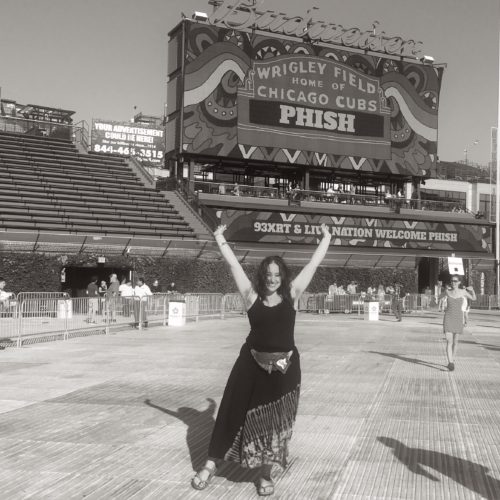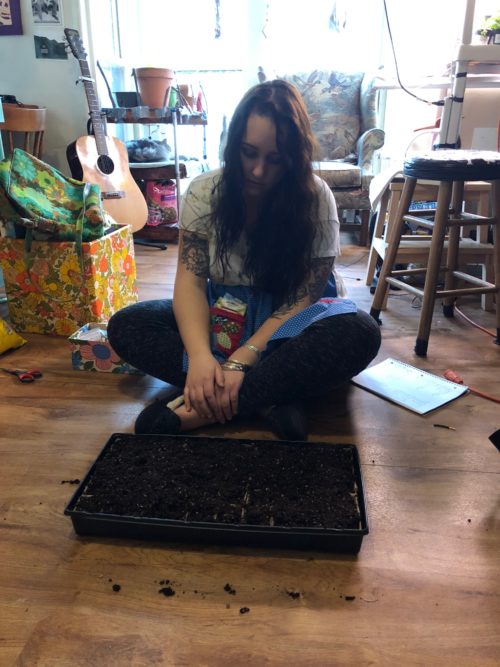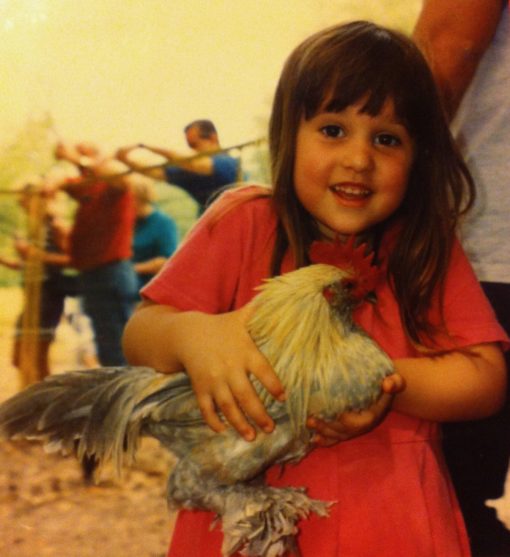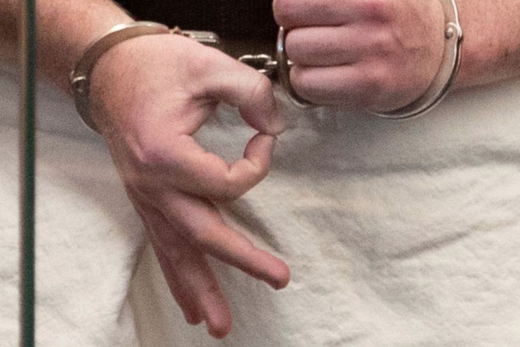When I first started my “History of Zines” oral history project back in 2013, one of the first people I reached out to was Sean Tejaratchi, the man behind the incredibly ambitious clip art zine Crap Hound. [As someone with OCD, the obsessiveness of Crap Hound really resonated with me, and I wanted to find out more about how the “picture book for discussion and activity” came to be.] While Sean and I had never met, we’d corresponded with one another for several years, back in the mid ‘90s, and I thought, given our previous conversations, that he might be up for talking on the record with me about his work. Well, I was wrong. He wasn’t at all interested in rehashing the past. But I was persistent. [Sean just recently said that dealing with me was like “fighting a hydra.”] Every nine months or so, I’d reach out to him, asking if he’d had a change of heart, and, after a few weeks, I’d invariably get a polite yet direct response, informing me that he hadn’t. He’d send a note saying something like, “Talking about the past leaves me cold,” accompanied by a photo of a pigeon struggling to support an enormous, painfully-engorged human cock. [For those of you who aren’t familiar with Sean’s post-Crap Hound work, he’s known primarily for grafting human dicks onto birds. More on that later.]
In retrospect, I probably kept at it longer than I should have. And, eventually, Sean had to send me something approaching a cease and desist letter, which ended with the following. “I just don’t give a fuck about the wild ‘90s, and I think that will show,” he said. “They happened, they were fun, and I feel I’ve said whatever I needed to say about it all while it was happening.” A better man would have walked away, but I just kept sending potential interview questions. [“I totally understand, Sean, but why human dicks on birds, and not owl dicks on lizards?”] And, eventually, after about five years of this, he gave in. I suspect he did so just to make my badgering stop, but maybe my last email, which was mostly about the redemptive power of Jesus Christ, struck a chord. Whatever the impetus behind his change of heart, I’m incredibly thankful that it happened, not only because it’s yielded one of the funniest and most thoughtful interviews in this series, but because it’s given me and Sean an opportunity to reconnect as adults.
With all of that said, here’s my discussion with Sean Tejaratchi, a man deemed by Rolling Stone to have been one of the “25 funniest people on Twitter” half a dozen years ago.

MARK: Let’s start at the very beginning. What do you know of your birth story?
SEAN: Born grumpy in Los Angeles. That’s about it.
MARK: What year would this have been? Would I be right to assume that it was after the Watts riots of ‘65?
SEAN: Late October, 1970. Definitely after the Watts Riots in ’65, and of course after Captain Matthew Webb’s historic swim across the English Channel in 1875.
MARK: OK, so at pretty much exactly the same time that “Genie the feral child” showed up on the scene in LA in her handmade straitjacket…
SEAN: Yes, I was born at the height of the “feral child” craze. I’ve got photos of my infant self dressed in dirty rags, propped up in my crib with a hand-lettered “Caution! Feral Baby!” sign taped to my chest. My parents would make me wear a disheveled wig when they were entertaining, insisting I snarl and crawl around for guests until I was about twelve.
MARK: What were you folks doing at the time?
SEAN: My mom taught nursing and my dad worked as a sculptor for toy and novelty companies.
MARK: Would we know any of your father’s work? I know it’s probably too much to ask, but he didn’t, by any chance, design dongs for Doc Johnson, did he? I was just talking with someone a few days ago about their novelty output in the early 70s, and it would be an incredible coincidence if you had a familial connection.
SEAN: My dad insists he has no connection to novelty dongs, and I believe him. He did sculpt this niche/cult “Surf Monkey” figure in the ‘70s. And in the ‘80s, when he worked for Mattel, I remember he worked on Smurfs figures and Masters of the Universe toys, including Snake Mountain, Skeletor’s lair. There was lots of other stuff, but He-Man figures and sets were the big ticket items I remember most.
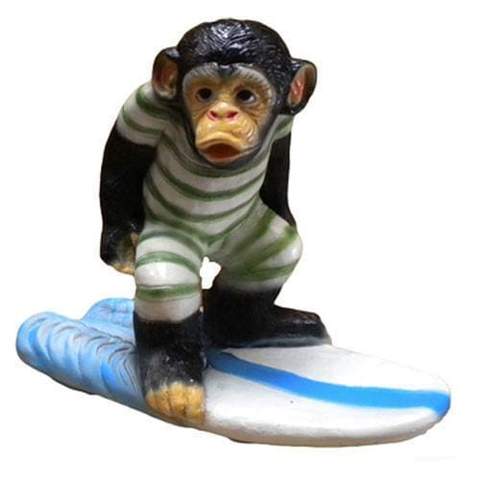
MARK: What’s your first memory?
SEAN: Floating inside my mother, looking around and feeling a vague sense of disappointment. I remember thinking, “I expected more from a womb.”
MARK: OK, so let me try again… What’s an early memory that’s stuck with you?
SEAN: I remember being picked up late one night at the babysitter’s house, carried mostly asleep and laid in the backseat of the car for the ride home. I was on my back, looking up at the backs of the seats and roof of the car, watching the shadows and orange streaks of the streetlights sweep across and disappear as we drove. I’m not certain, but I like to think I then shat my pants.
MARK: Which word best describes you as a kid: morose, precocious, friendless, exuberant, acerbic, obedient?
SEAN: Acerbic.
MARK: Were you ever in a band?
SEAN: I’ve never been in a band. I have no musical talent of any sort. Electric guitars are the devil’s radios.
MARK: How did you initially come to know that such a thing as zine culture existed?
SEAN: The first zine I ever had any direct contact with was Snipehunt, started by Mike King in Portland and eventually turned over to a woman named Kathy Molloy in Eugene. It was a local music zine, tabloid size, offset-printed and distributed mostly in the Northwest. After that, Chloe Eudaly’s store Reading Frenzy in Portland was my introduction to many more zines. I think her store started in 1994, the year I began Crap Hound.
MARK: How did you discover Snipehunt, and did you eventually become a contributor?
SEAN: Around 1989/1990, I began designing posters for Eugene’s WOW Hall. Kathy Molloy was booking shows, and we began dating. I was introduced to Snipehunt and Mike through Kathy while I was still in Eugene. I’d been planning to move to either Seattle or Portland, and since she was planning to move to Portland to work on Snipehunt, and I knew no one in Seattle, Portland seemed like the saner choice. I eventually helped, along with many others, on layout and the rare bit of writing until the final issue in 1997. Oh, and I drew a cover in 1994.

MARK: According to the caption accompanying your drawing, the heads adorning Molloy’s belt on this cover that you drew are those of the Snipehunt writers. I’m curious to know if one of those heads is yours.
SEAN: Yes, I drew myself on the other side of the belt, just out of view.
MARK: How old would you have been when you decided to move to leave Eugene and head to Portland?
SEAN: I was 19.
MARK: How did you come to know Chloe, who, I should add for folks who might not follow local politics in the Pacific Northwest, is now serving on Portland City Council? Did you first meet her as a customer, or did you know her before Reading Frenzy opened?
SEAN: I met her at mutual friend’s birthday party when she was 20, shortly after I moved to Portland, before there was a Reading Frenzy. I was at the party because Chloe was friends with my girlfriend at the time.
MARK: What, if anything, do you remember of that initial interaction with Chloe?
SEAN: Only that she seemed a bit more “adult” than average, more informed, and had her shit a few degrees more together than most of us. I remember she was interested in urban planning and other progressive social issues that I hadn’t really encountered at that point.
MARK: Did you start Crap Hound because of Reading Frenzy? Did you hear about Chloe’s plans for a store, and feel compelled to be a part of it?
SEAN: No, Crap Hound and Reading Frenzy simply arose around the same time in the same setting. The first issue of Crap Hound was sold in Reading Frenzy’s first location in SE Portland. The first shop was in SE Portland, so I didn’t visit much. Once the store moved to its second location, very close to the building downtown where I lived, I was there almost every day for at least a few minutes.

MARK: Was zine culture in Portland pretty active at the time?
SEAN: Very active. Everyone was doin’ a goddamned zine.
MARK: What were some of the zines from back then that you remember, other than Snipehunt? And was it social? Did you actually know these other folks, or just know them through their work?
SEAN: I knew a bunch of other zine-makers, largely because of Reading Frenzy. I remember Danzine, a zine for sex workers, exotic dancers, anyone in Portland’s pretty significant adult business world. I was fond of Heinous by Steve Mandich, which was devoted to Evel Knievel, and Dan Howland’s magnificent “Journal of Ride Theory,” focusing on amusement parks and related entertainmentary delights. Dishwasher Pete stayed in Portland off and on for a while, so a few issues of “Dishwasher” were locally produced. I did a cover for Pete, in fact. I met Jim and Debbie Goad of Answer Me!, who had moved to Portland, and witnessed the fiery birth of Larry Crane’s zine Tape Op (“The Creative Music Recording Magazine”), which is not only still around, but thriving. I’d say I knew everyone on that list well enough that I could walk up and start aggressively massaging their shoulders without any problems. Upper arms, too, probably down to lower back in most cases.
I stopped listing titles because the next step was going to look at my zines and turning this into a long series of shout-outs so I don’t forget anyone. To those I’ve already failed to mention, I’m sorry, goddammit.
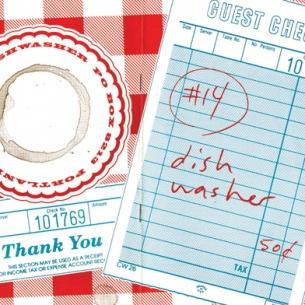 MARK: Can you talk a bit about the influence of Reading Frenzy? There were a few well-known zine shops around the country at the time, like Atomic Books, Quimby’s, and See Hear, but it seemed to me that Reading Frenzy did more to foster a sense of local community among zine publishers. Would I be right about that?
MARK: Can you talk a bit about the influence of Reading Frenzy? There were a few well-known zine shops around the country at the time, like Atomic Books, Quimby’s, and See Hear, but it seemed to me that Reading Frenzy did more to foster a sense of local community among zine publishers. Would I be right about that?
SEAN: I don’t know how Reading Frenzy compared to independent press shops in other cities, but the setting definitely helped. The store’s second, longest home was a block downhill from world-famous Powell’s Books. Reading Frenzy had cross-traffic and referrals from the staff at Powell’s, and the downtown location made it very easy for anyone to drop by. More customers meant more cross-pollination among creators, more community, more zines, more variety, more of a well-earned national reputation.
Chloe created a place where people could drop by and find practical connections or advice. She took anyone’s zines on consignment. Besides regular magazine and book shipments from distributors, the amount of self-published material meant there was new material on the shelves throughout the month. When the Independent Publishers Resource Center opened upstairs in the same building, the block became even more valuable to new creators.
MARK: What can you tell us about the Independent Publishers Resource Center?
SEAN: The IPRC was set up in 1998 by Chloe and a woman named Rebecca Gilbert, who I think is still involved in running it. It was started in office space upstairs in the North Pacific Building, a few floors above the storefront occupied by Reading Frenzy. You could exit Reading Frenzy and walk a few feet down the sidewalk on Oak Street to reach the stairs to the IPRC. The Center had a zine library, but more importantly it offered free, or very low cost, practical expertise and equipment to anyone of any age who needed help self-publishing. Volunteers could show you how to arrange printer spreads, set you up with a laser-printer, scanner, long-neck stapler for DIY binding, and so on. They held classes and organized events and fundraisers. The spirit of the place was very open, and, as I recall, admirably focused on the practical side of zine creation.
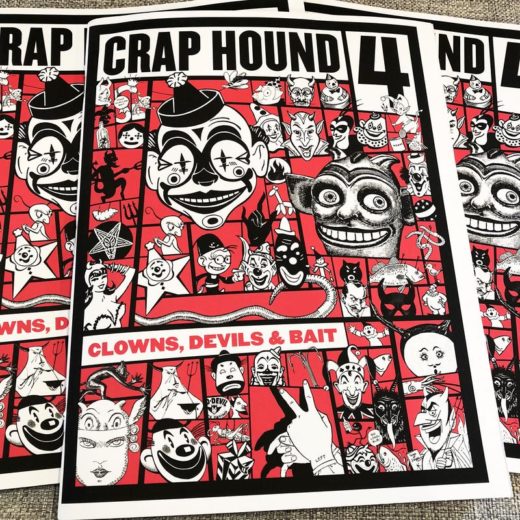
MARK: Like me, and a great many other zine publishers, you worked at Kinko’s, correct? Would I be right to assume that you made use of the copiers while there for your own projects?
SEAN: I worked at Kinko’s in downtown Eugene when I was 18, and then at a Park Blocks location when I moved to Portland. You are correct, I made constant use of the machines. I extended heavy discounts to friends and met a number of lovely customers who went on to enjoy similar savings. I’m still friends with one of my coworkers from the Eugene days, in fact.
MARK: What can you tell us about Toad Licker?
SEAN: I went to University of Oregon very, very briefly, dropping out after three days. I decided I’d much rather work hard and learn things on my own, taking whatever jobs could teach me more. My dream job was doing posters for rock shows. Typically posters were done by band members, their friends, or the venues themselves. I knew no one in any of those groups.
I eventually wondered if maybe that wasn’t really a problem. I decided I could make posters regardless, cutting out the middleman and inventing the bands myself. I used some of the images I’d saved from the recycling bin at Kinko’s and took the name from a Weekly World News headline.
I just looked it up, what a miracle we have in the internet: “TOAD LICKER BUSTED! A Los Angeles man is awaiting trial in a Colombian jail after his arrest on the mind-blowing charge of licking hallucinogenic toads! Stanton Greer, 28, allegedly traveled to the South American country to procure Cane toads, which secrete an LSD-Iike substance through their backs and are prized by druggies for their mind-altering properties.” In retrospect, I wish I’d named the band “Stanton Greer.”
Taking advantage of the free copy situation at work, I put up posters all over campus and downtown Eugene. When I later approached the manager of Eugene’s WOW Hall about doing posters, the fact he’d seen the Toad Licker posters helped me get the job.
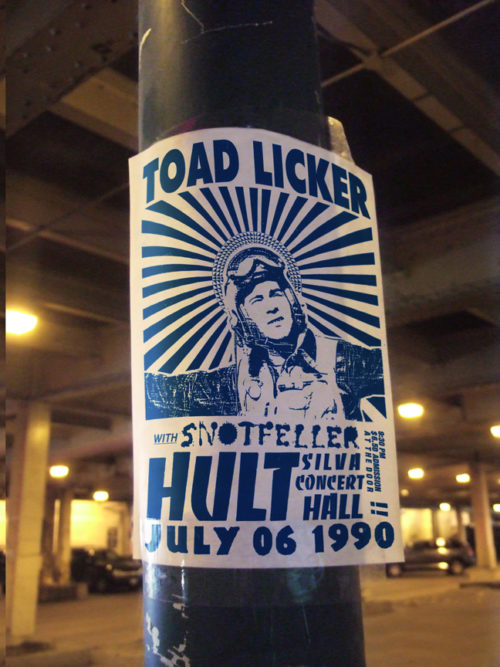
MARK: Was Crap Hound the first zine you ever produced?
SEAN: Yes.
MARK: Assuming you eventually left Kinko’s, how did you pay the bills back in the day, when you were publishing Crap Hound?
SEAN: I worked on the production staff at weekly papers: Willamette Week, PDXS, and I was art director at the Portland Mercury when it started. I was also on the design staff at Powell’s Books, too, come to think of it. I worked in the Powell’s coffee room, too. I designed quarterly calendars for the beloved Cinema 21 in Northwest Portland. And over about 10 years I designed (and often wrote) about 150 cards for the Stella Marrs postcard company in Olympia, Washington.
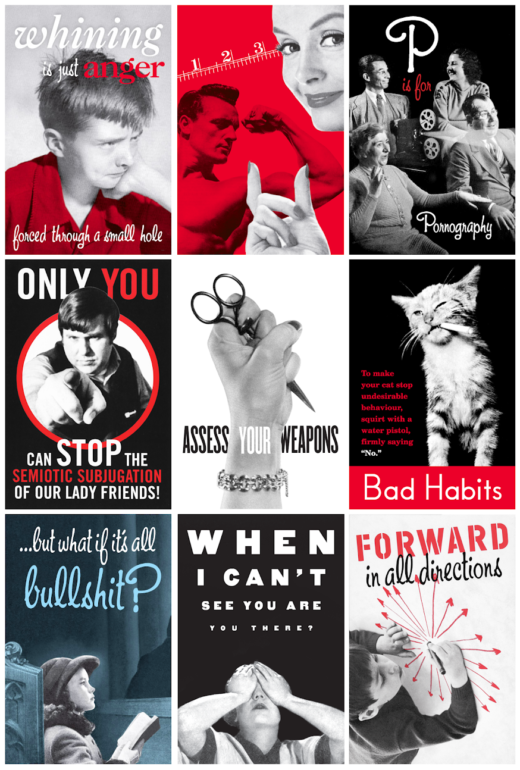
[above: Nine of the cards Sean designed for Stella Marrs.]
MARK: Did I hear somewhere that you were a tennis shoe designer, or is that complete fantasy on my part?
SEAN: I was never a tennis shoe designer, but I worked at the Adidas headquarters in Portland for about two or three years. I used the money to print the first few Crap Hounds, in fact. I designed a few t-shirts, but mostly I organized fonts, patterns, and resources for others.
MARK: How’d you get the job at Adidas? Did they find you, based on the work that you’d done for the likes of WOW Hall, or did you just apply?
SEAN: Another early job in Portland was making coffee drinks at a cafe in Old Town. One of the regulars became a good friend. He was a graphic designer, working at Adidas. He got me a job working freelance for small stretches. At some point the big boss guy hired me as a regular employee.
MARK: And how do you pay the bills now?
SEAN: I design books and take on other freelance design jobs that come my way.
MARK: I recall walking through a bookstore once, seeing your name on the cover of a book of murder scene photographs, and feeling happy for you. How’d that project come about?
SEAN: That was “Death Scenes.” It was a Feral House book. The publisher, the late Adam Parfrey, told me he was going to do a book featuring material in an old scrapbook kept by a Los Angeles Homicide detective in the ’40s. Author Katherine Dunn wrote the intro and I spent half a year working on it, refining images, isolating the handwritten captions from the paper backgrounds, things like that. Because of that book, I’ll always remember that on Christmas Eve of 1994 I realized I was spending the night painstakingly brightening the maggots on photos of dead boy’s face. That was a sobering moment. Still, I’m glad I did it. Everyone says the maggots look great.
MARK: Ah, I didn’t make the connection… Katherine Dunn, the author of Geek Love… Makes total sense now… Was that your first job with Feral House?
SEAN: No, my first Feral House job was The Devil’s Notebook, by Anton LaVey, in 1992. Very basic design, but I was thrilled to be working on an actual book cover.
MARK: Did you get to work at all with LaVey? If so, I’d be curious to know your impression of him. I seem to recall talking with Gregg Turkington about him once, as they worked together on the record Satan Takes a Holiday, but I can’t remember any stories… I’d be particularly interested to know if you ever had the occasion to visit his house and seen his animatronic drinking buddies.
SEAN: Sadly, no. I’d have loved to have met him, but I never came anywhere near him. The book work was done entirely through Adam at Feral House.
MARK: As you brought up Adam Parfrey, who just passed in 2018, I was wondering if you might say a few words about him. I’d never met him, but I was a fan, going back to his time at Amok.
SEAN: I met Adam in 1992, while I was working at a weekly paper. He’d just moved back to Portland, and needed help getting a couple of books finished and sent to the printer. I kept helping, and eventually moved on to bigger projects, dealing with authors, many of whom were fantastic people in their own right. Adam ended up being my friend and employer for more than 25 years. He was extraordinarily kind and generous to me, and lately I’m realizing there’s not much I can do to pay back this enormous cosmic debt I feel I owe him. I thought he’d be here longer. His sister Jessica is now running Feral House, so there’s comfort in the fact the company, and his work, will still be out there.
MARK: Could you perhaps share an anecdote about him, something he might have told you about his early days… anything that might offer some insight as to why he felt compelled to spend his life documenting these more obscure areas of the underground…
SEAN: Adam had plenty of subjects he was personally, deeply interested in, and they’re pretty easy to see in his essays and books he edited. When it came to his choices on what he published, my working theory was that Adam liked anyone who was passionate and obsessive. He appreciated those qualities for their own sakes, regardless of whether someone’s interests coincided with his own. His appreciation of others’ worlds was nuanced and often cautious, but it wasn’t ironic. On some basic level he loved people with complicated inner worlds and cosmologies.
I remembered a small, telling moment that reflects something of Adam’s contrariness: During the layout of a Feral House book cover, I showed Adam some cutesy or “clever” way to incorporate the barcode into the back cover design. Maybe it was a matter of working it into the illustration, or putting it in a funny little box that tied it to the topic in some way… I don’t remember the details. Adam’s response was firm and immediate: “No, I don’t want anything like that on our books. Stick it in the corner, don’t dress it up or disguise it in any way. It’s bad enough that the bar code has to be there. We don’t have to embrace it.” He felt it was one thing to have your choice in a matter curtailed, but a small, disgraceful defeat to then convince yourself you like it.
MARK: I promise I’ll get back around to you and Crap Hound in a minute, but, before I do that, I’m curious to know if you were around for the recording of Parfrey’s album, A Sordid Evening of Sonic Sorrows.
SEAN: I was around at the time, and I remember him working on it, but I wasn’t present for any recording. My impression was that because of the cameos and contributors, it was done off and on over a stretch of months.
MARK: OK, so how did the idea for Crap Hound come to you?
SEAN: I was in an office space where I lived and worked in downtown Portland. By this time several other friends were doing zines, and I’d helped them in various small ways. One day my idle chain of thought went like this: “My god, I’d never want to put my personal life or deep thoughts into a zine for others to read. I could never do that. —> Is there anything I *could* stand to do in a zine of my own? Probably not. Well, maybe a zine full of different alphabets would be tolerable. Just typefaces would probably be boring as hell for everyone else. —> Okay, what if I did a zine full of pictures, instead? That would be really useful, more fun to do, certainly more interesting for readers. —> Could I still do some alphabets and put them at the end of each issue? —> It’d be your goddamned zine, you could do whatever you want, motherfucker! —> Fuck yeah! —> Fuck yeah!” It struck me as a very tidy compromise, a way to do what I loved while still making something that was practical and useful to others.

MARK: As someone who never wanted to put his personal life or deep thoughts into a format for others to read, is doing this interview hell for you?
SEAN: My private life isn’t some big secret I constantly guard. I’ll happily talk about it one on one with people I know or meet. But while my private life is fascinating and engaging to me, that doesn’t translate into thrilling reading. My private life and history involves family and friends, and I try to consider their privacy, too. On top of everything else, I have this theory that as you tell others more and more about your life and views, the unconscious desire to appear consistent means it’s harder to gracefully change. I think announcing to everyone who you are and where you came from and what groups you’re part of and what you think about every goddamned topic under the sun inadvertently cements that version of yourself a little more firmly, and writes that version of yourself into everyone’s heads. I think it ultimately, ironically makes it harder to be yourself, and leads to a smaller, duller existence.
MARK: Can we talk a little more about this idea that “the more you tell others about your life and views, the unconscious urge to be a consistent person means it’s harder to gracefully change”? I’m curious as to when you arrived at this… I mean, it’s kind of antithetical to the whole zine ethos, which, at the time, was very much about spilling your guts, isn’t it? I’m just curious if you had this sense early on that, by divulging a lot, you’d find it more difficult to evolve, or if that idea was informed by perhaps watching your peers in the scene as they tried to move forward after exhaustively defining themselves in print.
SEAN: I think our desire to appear consistent to others is a dangerously underestimated force in the world. On the one hand, we don’t trust people who flit endlessly between ideas, subcultures, identities. A certain outward stability reassures people and gives them a strong hint that we have a core that won’t change with fashion or whim or convenience.
On the other hand, we’re obviously not the same people we were in high school, or twenty years ago, or five. Growth means change, so we experiment, trying on new views and jobs and friends and subcultures. It’s a clumsy process. It can be abrupt and jarring, and it usually looks embarrassing to onlookers.
Those two conflicting truths can coexist because of privacy. We learn we can share some things with some people and other things with other people. We hide aspects of ourselves from public view. We outgrow things. I think we grow between relationships (of any kind), not necessarily in them. In a zine or online, updating everyone about who we are and what we think makes it harder to reverse course or let go of what isn’t serving us well.
Everyone has said a lot of cringey shit, and everyone still holds some older ideas that might be currently unfashionable (but still seem valid). Not a day goes by now without someone being torn apart for some dumb thing they said or did in the past. Our ill-considered, embarrassing public statements are now searchable by keyword.
I want an interesting life, with all its contradictions, far more than I want to momentarily mass-connect with strangers. I’m not fake or endlessly agreeable when meeting new people, but I want to enter new interactions without bullshit identity politics. I want people to deal with me at face value, and vice versa.
Privacy also protects my friendships. I don’t want to use my personal conversations as fodder, repackaging them in exchange for the cheap enjoyment of strangers. It would make friends wary of me, and for good reason. It’s easy enough to understand how pointing a camera at someone influences their choices and behavior. If you’re constantly talking about your life, you’re the one holding the camera.
All this, right here, is another example why I hate broadcasting personal shit: I have friends who are smart, sensitive people. Let’s say they read these bullshit deep thoughts of mine. Will they suspect I consider them to be assholes who overshare or use private conversations as fodder? I could start explaining why I don’t, but it wouldn’t be necessary if I’d just kept my mouth shut. I’ve generated a potential insults simply because I momentarily valued making a few candid points. More needless pains in the ass.
The zine ethos, as far as I was concerned, was simply “You can do things yourself, without waiting in lines or hoping gatekeepers will give you the chance.” The (well supported) idea that zines = oversharing and endless “deep” navel-gazing was actually an obstacle for me, something I had to get over, or think around. If spilling guts and sharing bullshit feelings and godawful poetry was the only thing zines were good for, I’d never have made one. I’ve certainly liked a few zines that drank from that trough, but I liked them in spite of that aspect, not because of it.
MARK: I think it’s something we all had to learn to navigate in this little subculture of ours. We made choices as to what should be shared, and, quite often, we fucked up. And we learned from those decisions. I suspect, for instance, a lot of zines changed in tone once they were discovered by the parents of their authors. I can certainly see your point, that it might be better to step out of that altogether, but I do think there’s something to be said for jumping in and forcing yourself to go through that process. But, yeah, I’d agree that some things should be worked out in private, and I feel for those who perhaps over-shared early in their lives, before they fully comprehended the price that they might one day have to pay… While we’re on the subject, do you have any other advice for would-be zine publishers, or, for that matter, anyone at all who exists in today’s world, which, thanks to the internet, has kind of come to reflect zine culture? Are there other traps that you’d urge people to steer clear of?
SEAN: In no particular order: Those dazzling critical thinking skills and bullshit detection methods you employed to see through the Bad Guys™ might yield some really ugly insights when diligently applied to the Good Guys™. Don’t dismiss your nagging doubts as cynicism. Study animal behavior. Learn about the scientific method and the value of testing and falsifiability. Stop taking part in things that make you feel less real. Next time someone tells you there’s no such thing as objective reality, push them into traffic and take notes on how things go. Remember that people do shit for deep personal reasons and sometimes the best you can do is not make their problems your own. And remember everyone’s selling something, and the true topic of every speech (including this one, to be fair) is “Why You Should Be More Like Me.”
MARK: I agree with your point about zine culture, at least as it existed back in the early ‘90s, being about much more than just hyper-personal navel-gazing. There were a lot of great zines, like Crap Hound, that never went down that path. The thread connecting all of it, as you noted, was this liberating spirit of self-empowerment, the sense that people could do things for themselves “without waiting for others to give you the chance.” I’m just curious as to where, if anywhere, you see this same spirit today.
SEAN: The spirit that generates complex, honest, nuanced creativity is all over, but I think it’s extremely subdued right now. Daring to express the gentlest reservations about prevailing social obsessions has virtually no practical upside. People are waiting it out, hoping all this glaring insanity will subside. Of course that’s why it’s intensifying, but… oh well.
MARK: Where did you gather your images for Crap Hound? How far would you go in pursuit of old, odd, and quite often troubling imagery?
SEAN: I’ve been clipping and saving commercial art images for almost thirty years. If I come across old clip-art books, old magazines, newspapers, that kind of thing, I’ll either buy it or borrow it (if I can) and scan it (not so much photocopying any more). I’ll occasionally treat myself to an eBay purchase, maybe something fancy like old Reader’s Digests or a pile of water-damaged Better Homes and Gardens. I’ve slowly discovered online resources, places like Archive.org and various library collections.
MARK: Do you remember how you came to be interested in clip-art, fonts at the like? As you say it’s been about 30 years, would I be right that this interest of yours started as a kid, before you left Eugene?
SEAN: I’ve always had collections of things, and I’ve always valued the practical and useful. Looking back, around 12 years old I began keeping lists of colloquialisms, fragments of colorful idiomatic language (“crazier than a shit-house rat” for example). By my senior year of high school, I’d started saving images in scrapbooks, without any particular goal in mind. Crap Hound was something that let me justify putting time and effort into that compulsion, resulting in something tangible and useful.
I had an epiphany not long ago, while I was trying to work out whether Crap Hound had anything in common with my LiarTown site, a place to post satirical nonexistent realities and products. I figured out that Crap Hound is a place to document and catalog familiar, popular art and styles, and LiarTown is where I get to rearrange those patterns into odd configurations.
MARK: If there were to be another issue of Crap Hound, what theme would you build it around?
SEAN: The next issue of Crap Hound is nearly ready for the printer. It’s a 550 page book entitled “The Crap Hound Big Book of Unhappiness.” It’s an enormous tenth issue in horizontal format. I’ve packed in everything from bacteria to thermonuclear war. I’m done with the pages, almost done with the intro. It’ll be out in Fall of 2019. The issue after that is possibly “Books and Reading.” That sounds nice. Be warned, though: Every time I announce something this far ahead, I change my mind.
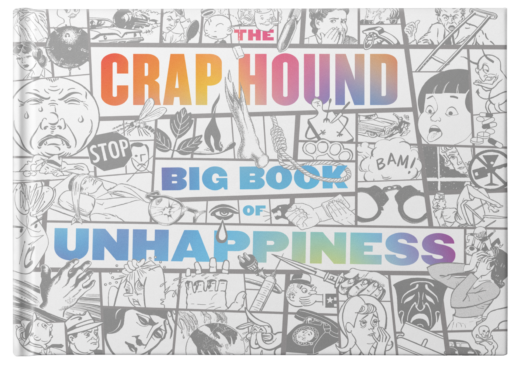
MARK: What first brought you back to Crap Hound after so many years away from it?
SEAN: I’d been moving around the country a bit, taking a break from Portland. All my archives and files were in storage, and I was too busy with real work to focus on personal projects. In 2005, once I was settled back in LA, Chloe offered me the chance to have everything I wanted with none of what I didn’t. She suggested I continue creating Crap Hound, doing whatever I wanted, and she’d pay for printing and handle distribution. Some of the profits went to Reading Frenzy. It worked out very well for everyone.
MARK: I probably should have asked you this earlier, but did you help Chloe with her campaign posters and the like when she ran for Portland City Council? I’m trying to imagine what a political yard sign informed by the Crap Hound design aesthetic might look like…
SEAN: Nope, as far as I know, everything was designed by her campaign team working in Portland. I saw some of the posters and flyers when they were finished, but I had no part in designing them.
MARK: Somewhere around the house here, I have a letter from about fifteen years ago, in which you threaten to beat me up. In your defense, I think I probably started it.
SEAN: I don’t remember this at all. It’s safe to assume I was joking, holding your hand as we soared on a lighthearted flight of violent fancy. I am certainly one to enjoy an absurdly detailed fake-threat, but seriously threatening to beat someone up has never been my style.
MARK: And what is your style?
SEAN: My style is less outright violence, and more arranging life so I don’t have to pretend to give a shit about things and people I don’t like.
MARK: And how’s that working out for you? Have you successfully created the perfect bubble?
SEAN: The last fifty or so uses I’ve read of the phrase “a perfect bubble” have had negative connotations, so if that’s how it’s used in your question, I should point out my policy doesn’t necessarily lead to an insulated echo chamber. If I don’t want my own opinions repeated back to me in different words, or if the people I want to avoid are the ones pushing homogeneity, that wouldn’t seem to lead to life in a bubble. Just the opposite. The devil’s in the details.
Besides that, everyone has that goal. No one’s seriously trying to spend more time around assholes they can’t stand and don’t respect, or doing things they hate and see no point in pursuing.
If you meant “a perfect bubble” in a positive sense, then things are very good. I have interesting, challenging projects to work on, and I get to deal with people from many backgrounds who hold a very wide range of views. I’m drawn to interesting, genuine people, and it appears many of them find me at least tolerable. Things could be much, much worse.
MARK: When I used the word “bubble,” I wasn’t trying to convey anything, either positive or negative, but I can see how that word might have a negative connotation. I was just wondering if you’d been successful in your attempt to arrange your life so that you don’t have to give a shit about things and people you don’t like. It seems to me to be an impossible undertaking.
SEAN: It’s impossible to ever perfect, but it’s still a very useful ideal. It helps me keep my eye on the ball when I’m making choices in life. I might occasionally be ruthless about these things, but that’s the direct result of not being very ruthless about them in the past.
MARK: Any regrets at all around the Crap Hound experience?
SEAN: Two very minor things. I regret using the subtitle “An Encyclopedia of Clip Art” for the first two issues. If there’s one thing Crap Hound is not, it’s clip art! My goodness, no. Crap Hound is reference. It’s a visual, cultural overview, over-indulgently laid out in a ways that keep it interesting and fun for me. The other regret: I shouldn’t have bothered numbering them. It should’ve just been “the Death, Telephones, Scissors issue” and so on. I underestimated my own enjoyment of revisiting past topics. Not a great tragedy, but an early choice that led to very slight but consistent and needless confusion.
MARK: Can you talk a bit about the transition between themes in Crap Hound? I’ve always loved the clip-art itself, but the inspired transitions between topic areas is always what I most looked forward to in Crap Hound.
SEAN: I was about to say I don’t often have material I can use to overlap/merge, but now that I think about it I’ve been pretty good about the transitions. Images that bridge two topics get set aside early, held in reserve. They sometimes influence the order of topics. In Death, Phones, and Scissors, for example, having a picture of an anguished character phoning a suicide hotline will make it much more likely I’ll have Phones and Death next to one another (rather than separated by Scissors), just so I can have that pic in the transition.
What’s really rare are the three-way overlaps. I can remember only a few occasions when a graphic managed to hit three parts of an issue. There was one in Clowns, Devils, and Bait—a midge-fly larva used in freshwater fishing, commonly called a “joker,” a character occupying a midpoint between older Mephistophelean devils and mischievous harlequin clowns. For the Hands, Hearts, and Eyes issue, I found an antique chapbook woodcut that read, “The Eye finds, the Heart chusyth, the Hand binds, but Death Loosyth.”

[above: The transition between sex and kitchen gadgets in Crap Hound #9. A larger version can be found here.]
MARK: So do these transition images inform the range of topics you take on in a specific issue? In other words, are they the pieces that you build out from? Or do they come later, kind of happy accidents that you happen across, once you’ve decided on the topics you’re going to be addressing?
SEAN: No, they aren’t a factor in how I choose topics. At most, transition images might affect the order of the topics within. They’re definitely happy accidents, and always get special treatment during layout.
MARK: Were all of the images in Crap Hound found, or were there instances where you created some? Were you ever tempted to do so?
SEAN: Now and then I will hand-draw some very, very slight decorative or filler material. For the issue I’m working on now, I drew some stars, a few very tiny skulls (a quarter inch wide), tiny clouds of specks that could conceivably be locusts, things like that. Drawing my own material defeats the purpose, generally. I’m trying to give a look at what our culture means when it uses certain terms, not what I mean, or what I can draw. Even drawing filler material like that is a last resort for me. I try to avoid it. If I can find what I need from existing sources, it’s much better, both in terms of quality and relevance.
MARK: Best letter from a reader?
SEAN: It’s been decades. I can’t remember best or worst. It’s like asking me to recall the best phone call. I DO still think about the day in 1990-something when actor Michael McKean came into Reading Frenzy (I was filling in at the register) and asked if the store carried Crap Hound. That was a glorious moment in my personal history.
MARK: We used to get letters from a old man named John Coffin. He would write these long letters about Charlie McCarthy, the figure operated by ventriloquist Edgar Bergen. As we’d later learn, he was arrested for pulling a gun on someone at a public library. It would seem as though he carried a pistol in a metal coffee can that he wore on a string around his neck… He also used an ear trumpet… As for McKean, Did you tell him who you were?
SEAN: I told him we were out of the issue he wanted, but I introduced myself and told him I’d be happy to send him one from my stash at home. He wrote down a mailing address, and I thanked him for Spinal Tap. He moved to leave, but then turned and announced in a voice choked with tears, “Sean, thank you for all your hard work and tasteful arrangement of tiny pictures. Your exemplary work ethic and design skills have helped keep my family together during some rough times, and in many ways large and small you have been responsible not just for my own professional success, but for the careers of many big Hollywood names and federal judges.” I was speechless. I mean, what do you say to something like that? I just walked over and held him silently in my arms.
MARK: If you had to name one, what’s the attribute that you think most zine publishers probably have in common?
SEAN: Impatience, restlessness, or dissatisfaction. I think a typical zine publisher is fascinated by a certain corner of the world, familiar enough with it to know how they wish it were covered, and finally motivated enough to start covering it themselves when it becomes clear no one else will do it the way they’d want.
MARK: I’d be remiss if I didn’t ask you about LiarTownUSA, which you alluded to earlier… Can you talk a bit about how the idea for the initial Tumblr feed came about?
SEAN: I started using Twitter in 2010, sticking to jokes. Now and then I’d use Photoshop to make a fake book cover or porn mag, or an imaginary Netflix summary. Over time I noticed that was actually more satisfying and fun. Around 2014, when I no longer wanted to wade in the chemical toilet of misery Twitter was fast becoming, I established LiarTown on the blogging site Tumblr, keeping things very simple. I posted everything visual I’d created for Twitter up to that point, then began regularly adding material after abandoning Twitter completely.
MARK: And how did things evolve from there? When did you decide to make the jump from Tumblr to the real world?
SEAN: The only conscious change I made between 2014 and early 2018, when I paused to put the book together, was deliberately creating a wider variety of material. It was my way of reserving the right to do whatever I pleased in the future, ensuring later experimentation wouldn’t be unprecedented or out of place.
LiarTown has been paused for the moment. Tumblr no longer allows anything sexually explicit. No more huge pigeon cocks, no more fake porn magazines, no more lots of stuff. Old posts are still there at the moment, minus the objectionable stuff they deleted. Rather than dumb things down in the future or avoid NSFW ideas altogether, I’ll reestablish the site somewhere else.
MARK: When did you start putting out calendars?
SEAN: There’s a good story behind the start of real-world calendars. In 2014 I posted a mockup “Social Justice Kittens” calendar on Twitter. I’d taken a few heroic quotes from online activists and combined them with darling little kitten photos. Nothing very involved, just a cover and two sample months. It got a very positive feedback, including a reply from actress Martha Plimpton, who runs a pro-choice/reproductive rights organization called A is For. She loved it, and asked where she could buy one. Now, I’ve always been a huge fan of abortion. So I sent her a private message saying, although it’s not a real calendar, if her organization paid for printing, I’d happily design a full 2015 calendar, free of charge, and let A is For keep all profits. She immediately agreed. Lots of enthusiasm. Green light, “let’s do this!,” etc., etc. I got to work, and a few months later emailed her to tell her it was nearly finished. No reply. Sent another email. No reply. I kept working, figuring she might simply be busy. When the print deadline arrived, I sent a third urgent email and a message on Twitter. She finally responded, apologetically explaining she couldn’t do the calendar. A is For had just held a “Night of a Thousand Vaginas” fundraiser that had been vilified by trans activists because saying “women have vaginas” was apparently transphobic. Martha now felt anything that might possibly be interpreted as less than one million percent woke was a bad idea. She DID courageously suggest I print the calendar myself and donate all profits to her group. I thought, “Well, feminism is fucking doomed,” and called a publisher I work with in Portland instead. They went for it, and it was sold out by New Year’s.
I did an Apple Cabin calendar in 2016, and two more SJ Kittens calendars for 2018 and 2019. I’ve also made social justice kitten and puppy postcards, as well as a couple sets of LiarTown images.

MARK: For what it’s worth, I’ve really enjoyed you LiarTown output. While I had a feeling for your sense of humor from Crap Hound, it’s much closer to the surface in your LiarTown work.
SEAN: LiarTown is the most “me” thing I’ll ever do. It’s meant as an archive, a way to get ideas out of my head and make room for more. It’s a place for things I wanted to see made, and things that make me laugh. I don’t have to stick to a particularly rigid format, or do what people like. It’s not a way to make a living. I don’t have to run anything by a boss or publisher or committee.
MARK: It’s been requested that I ask you specifically about Birds with Human Penises, how the idea came to you, and whether you considered the placement of human sex organs on other animals…
SEAN: I’ve never, not once, considered placing human sexual organs on other animals besides birds. Also humans, sure, fine. What the hell kind of person sits around imagining human genitalia on non-avian animals?
You know the Voight-Kampff test in the movie Blade Runner? It’s that scene where the administrator sets up the eye magnifier doo-dad and begins to ask emotionally difficult questions, trying to determine whether the subject is an android. I’ve always loved that scene, and at some point I began thinking of other questions that might’ve been left on the cutting room floor. Eventually I took screen captures and added my own subtitles in Photoshop.
In the subtitled pair of frames I made, the test administrator first addresses the replicant Leon: “You’re napping in a backyard hammock. You wake to find a sparrow perched on your chest.” In the second frame, Leon stares back wide-eyed as the administrator adds, “It has a semi-erect human penis.”
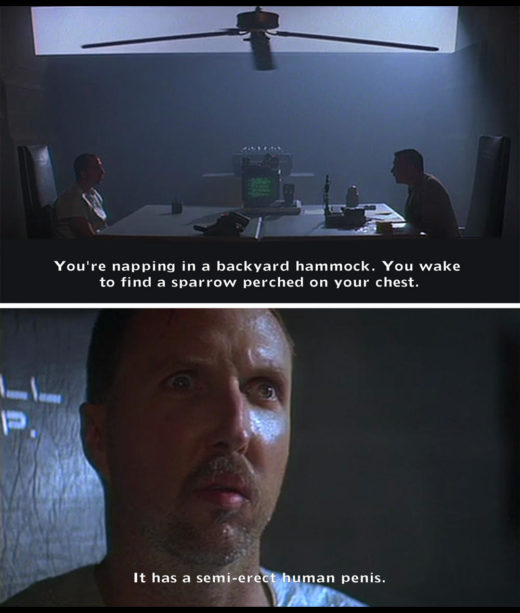
I know “I came up with it quickly because I needed something right there on the spot,” is not a very insightful story. It arrived with the perfect amount of emotional disturbance, both fascinating and repulsive. It immediately creates a horrible log jam of unpleasant questions and protests in the mind. I loved it enough to return to the idea a few times, first as a fake calendar and later as two imaginary collector’s plates.
MARK: OK, I didn’t know this, but, according to Wikipedia, you worked with Miranda July on her film, Me and You and Everyone We Know, which makes me think that maybe you were responsible for the symbol used to indicate the eternal moving of poop back and forth between two people… ))<>((. Did you have a hand in that?
SEAN: I knew Miranda from Portland. I used to help on her women-led film distribution projects, doing VHS covers and CDs for her. When I moved back to LA, she asked me if I’d want to make some fake things for Me & You and then her second film, The Future, a few years later. Very recently I did more material (In-flight magazine cover, with logo of a nonexistent airline! Community book sale flyers for a church basement scene! Post-office reward flyers! Golf tournament TV graphics!) for her still-to-be-named film that’s currently in post-production. I designed props, signs, background posters, etc., along with other designers, always under the direction of the art director. I had so much fun packing nonsense into the fine print and background detail, knowing it would never be legible. As much as I wish it were mine, the ))<>(( symbol was entirely Miranda’s. I have a carefully preserved brown ))<>(( t-shirt from the wrap party that I will probably never wear because it’s too magical.
MARK: OK, one last thing. The other day I mentioned to Linette that we were doing this interview and she told me that she’d just heard your name on NPR, and that she thinks you might be a writer on the new Prairie Home Companion, or something. If this is true, I’d love to hear your plans for the people of Lake Wobegon.
SEAN: I wrote for two years— the last year it was called A Prairie Home Companion, and then for the first year under its new name “Live from Here.” I arrived after Garrison Keillor had retired. I never met him. The new host, Chris Thile, knew LiarTown and asked me to submit/audition for the show as he was preparing to take over. I ended up as one of a handful of writers working on comedy sketches. It was definitely not something I’d have ever predicted myself doing, but I had such a great time. They were incredibly patient with me, gently turning down whatever clearly inappropriate ideas I’d pitch. I came SO close to getting a “just the tip” joke on NPR. Other pitches, like my Westworld/Prairie Home crossover sketch where you could kill or fuck absolutely anyone in Lake Wobegon, were decisively shut down much earlier.
Among other things, I wrote Bertrand Falstaff Heine, the bitter failed wine critic. I made a wee tiny overlap with LiarTown in one sketch. The band Bertrand interviews, Mary a Ship Won’t Sink, has an album I included in the LiarTown book.
MARK: So, what’s next for you? Are there other LiarTown products in the pipeline?
SEAN: I’ll make more postcards and calendars as time allows. Right now my main concern is getting the Crap Hound Unhappiness book done. After that, I have to find a new home for LiarTown. Once it’s reborn, I’ll get back to making dumb things. After that, I’ll start work on the next Crap Hound issue. And when all that’s finally set, I’ll be able to devote more time to my colonics and interior wellness spa.
Place your order now for the Crap Hound Big Book of Unhappiness, and be sure to pick up all of the back issues of Crap Hound, as well tons of other Sean Tejaratchi merchandise, at Buy Olympia… Oh, and if you haven’t already, check out the other interviews in the Untold History of Zines series.


